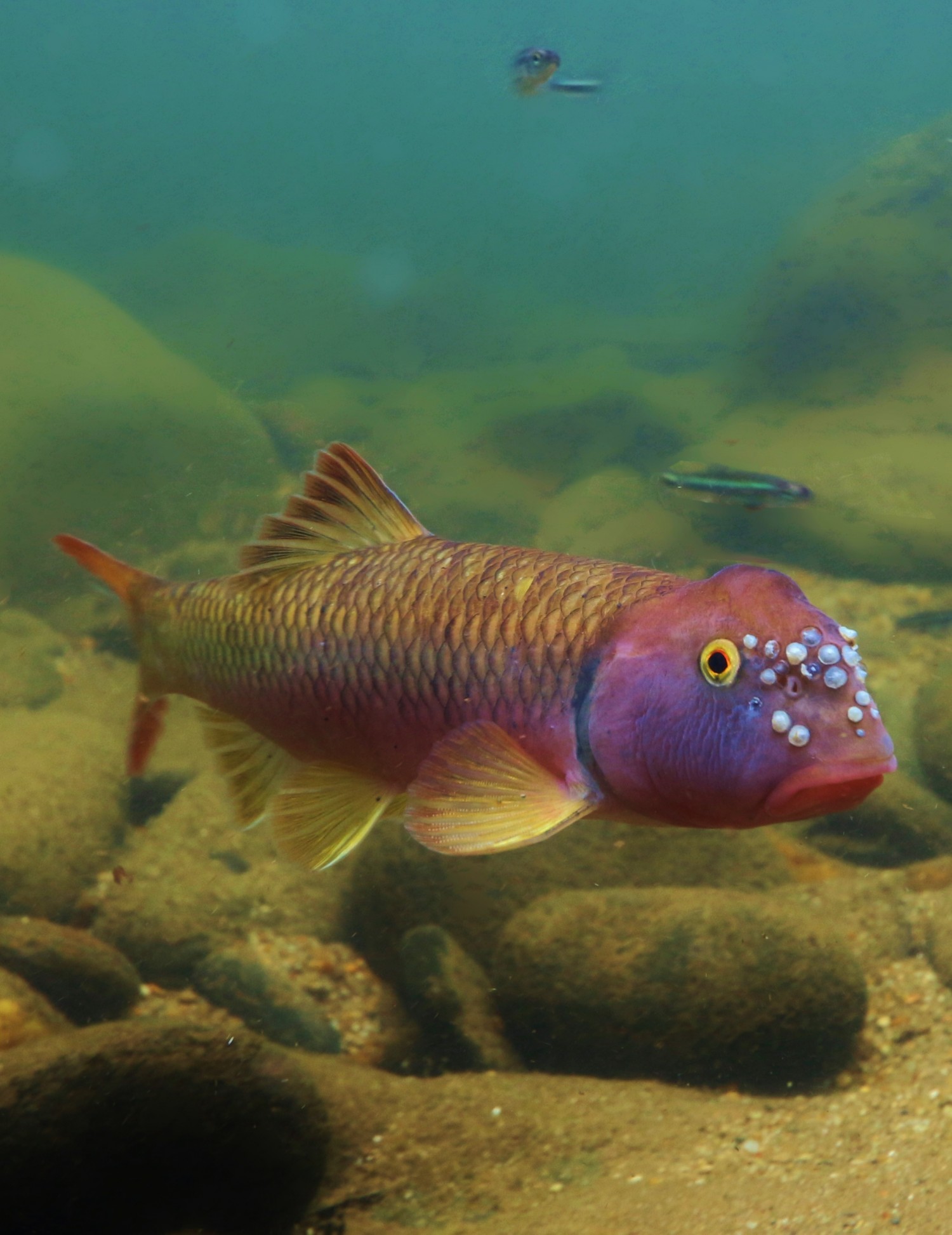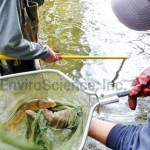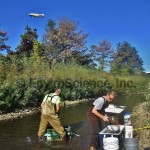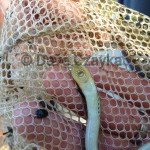Our Ichthyologist Team
Performing fish surveys in streams and rivers has been a major component of EnviroScience’s projects since 1994. We have sampled over 4,000 locations across the United States, as far east as Cape Cod, Massachusetts, and as far south as Alabama. We have the capabilities to sample any size body of water using electrofishing equipment, seines, hoop nets, trap nets, trawls and gill nets. Furthermore, our team has over 75 years of combined experience with fishery data analysis, providing comprehensive, in-house, tailored services to our clients,  including:
including:
- Fishery evaluation – fish survey followed by a detailed report containing comprehensive data analysis, imagery generation, and management recommendations where applicable
- Nuisance species management – removal of unwanted fish species such as carp, large gizzard shad, etc.
- Fish surveys collecting fish for various purposes such as tissue analysis or consumption advisories
- Bathymetric surveys using the latest in Global Positioning Systems
- Habitat evaluation and improvement recommendations and design
- Comprehensive water quality sampling and lake diagnostics
- Qualitative and quantitative analysis of zooplankton, phytoplankton, and ichthyoplankton
Fish Communities as Bio-indicators
Fish communities are an excellent indicator of biological integrity due to their continuous exposure to ambient water conditions, and because they display a variety of responses to environmental disturbance, such as habitat alterations, organic enrichment, chemical toxicity, and thermal fluctuations. Therefore, they are an integral part of any bio-monitoring program.
EnviroScience biologists have extensive experience using Ohio EPA’s Index of Biotic Integrity (IBI) and Modified Index of Well-Being (MIwb) to biological integrity. These protocols have been instrumental in monitoring the reclamation and/or degradation of Ohio’s streams. EnviroScience has also adapted these protocols to the overlapping ecoregions in surrounding states, and uses the federal Rapid Bio assessment Protocol R.B.P. where needed.
EnviroScience uses the most current methodology to assess fish communities in water bodies ranging from small headwater streams to The Great Lakes, North America’s largest freshwater bodies of water. Most fish collections use pulsed DC electrical currents which temporarily stun the fish to allow for net capture. In captivity, the fish are examined for anomalies, weighed, measured for length, and quickly released unharmed. EnviroScience employs the typical electrofishing  methods: backpack, long-line, tote barge, and boat.
methods: backpack, long-line, tote barge, and boat.
Qualitative methods can be used to supplement quantitative fish data. For example, sampling equipment can be employed to target specific species or groups of fishes. This equipment includes experimental gillnets for general species, seines for near shore species, hoopnets for bottom dwelling species, and trawls for pelagic species. Icthyoplankton sampling and identification for entrainment and impingement
[316(b)] is an EnviroScience specialty. Other methods such as underwater video and sonar are also available.
Fisheries & Fishery Evaluations: A Valuable Management Tool
EnviroScience biologists have extensive experience conducting full-scale fishery evaluations from small private ponds to Lake Erie. Our experts have sampled over 4,000 locations throughout the U.S.—providing them an even greater understanding of the biology and ecology of fish communities. Three factors are needed to sustain a viable fishery in any system:
- Habitat: water quality, cover, plants, depth, substrate
- Food: invertebrates, forage , plankton
- Reproduction: adult survival, recruitment of young fish to maturity, spawning habitat

An analysis of these factors in combination with abundance and diversity data is an excellent assessment method for fishery and lake health. Fisheries are sampled using a variety of techniques including electrofishing, hoop netting, seining, gill netting, Global Positioning System technology, and Geographic Information System software.
Oftentimes, several methods are used simultaneously to ensure adequate sampling in all habitats. For example, hoop nets target bottom dwelling species sometimes missed by electrofishing. EnviroScience personnel analyze the data to assess fish population dynamics and health, which are used to develop best management plans for stabilizing or improving the fishery.
Recommendations may include harvest restrictions, stocking or habitat improvement. Our proactive approach encourages close work and communication with the client, lake association, and other principal stakeholders. Each project is tailored to the specific needs and goals of the lake.
Data Analysis
Our staff has extensive experience with fishery data analysis, including:
- Presence / Absence based on historical and habitat data
- Spawning
- Community Comparisons
- RIS (Representative Important Species)
- IBI (Index of Biotic Integrity) Relevant in OH, KY, GA, among others
- RBP (Rapid Bio assessment Protocol) for State and Federal Projects
- Thermal Tolerance/Analysis
- 316(a) and 316(b) Data Analysis and Consulting
- Index of Well Being (IWB) and Modified Index of Well Being (MIWB)
- Catch Per Unit Effort (CPUE)
- Predation and Gut Analysis
Fish Surveys in Action
- Greenfin Darter – Etheostoma chlorobranchium
- Spanish Mackerel –Scomberomorus maculatus collected for Human Health sample during USEPA NCCA
- Southern Flounder –Paralichthys lethostigma collected for Human Health Sample during USEPA NCCA
- Chlorophyll-a and Enterococci water quality filtering USEPA NCCA
- Brook Trout – Salvelinus fontinalis collected during an ES electrofishing survey
- Bonnethead Shark – Sphyrna tiburo collected during USEPA NCCA
Need help with your project?
Our experts are here to discuss your needs and how we can help you move your project forward. Fill out the form below for more information on our services or to request a quote and we’ll get back to you within 24 hours. If you need a response within an hour or less, please call us at 800-940-4025.
Few environmental firms in the country retain EnviroScience’s degree of scientific know-how, talent, and capability under one roof. The diverse backgrounds of our biologists, environmental engineers, scientists, and divers enable us to provide comprehensive in-house services and an integrated approach to solving environmental challenges—saving clients time, reducing costs, and ensuring high-quality results.
Our client guarantee is to provide “Excellence in Any Environment,” meaning no matter what we do, we will deliver on our Core Values of respect, client advocacy, quality work, accountability, teamwork, and safety. EnviroScience was created with the concept that we could solve complex problems by empowering great people. This concept still holds true today as our scientists explore the latest environmental legislation and regulations and incorporate the most up-to-date technology to gather and report data.
EnviroScience expertise includes but is not limited to aquatic surveys (including macroinvertebrate surveys and biological assessments); ecological restoration; ecological services (including impact assessments, invasive species control, and water quality monitoring); emergency response; engineering and compliance services; endangered mussel surveys; laboratory and analysis; stormwater management; threatened and endangered species; and wetlands and streams (including delineation and mitigation). Further, EnviroScience is one of the few biological firms in the country that is a general member of the Association of Diving Contractors International (ADCI) and offers full-service commercial diving services.

























